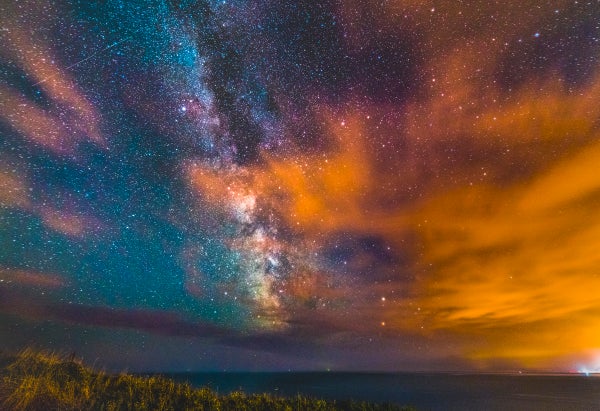Our sun is not a typical star. Most stars are one tenth as massive and will live hundreds of times longer than the sun. Moreover, most stars formed billions of years before the sun, based on the observed star formation history since the big bang.
Why were we born so late in cosmic history around a relatively massive star like the sun? Statistically speaking, we were more likely to exist earlier or around a lower-mass star.
The Copernican principle asserts that we are not privileged observers of our universe. It stems from the discovery made half a millennium ago by Nicolaus Copernicus that we are not located at the physical center of the cosmos as thought previously. If this mediocrity principle applies to all of our cosmic circumstances, then there must be physical reasons for why our particular form of intelligent life did not arise around an early or dwarf star.
On supporting science journalism
If you're enjoying this article, consider supporting our award-winning journalism by subscribing. By purchasing a subscription you are helping to ensure the future of impactful stories about the discoveries and ideas shaping our world today.
Two obvious explanations come to mind. First, the material that assembled to make early stars lacked the heavy elements that are essential for life as we know it. This includes the heavy elements that make rocky planets like the Earth, as well as the oxygen and carbon needed for water-based organic chemistry. Second, dwarf stars are fainter, bringing their habitable zone closer in. Given this proximity, Earth-like planets would have their atmosphere stripped by stellar winds or their surface sterilized by UV flares from these dwarf stars.
Nevertheless, many sunlike stars with a similar heavy element abundance must have formed long before the sun because we see the products of their death as white dwarfs. It is therefore difficult to imagine that we are the first advanced civilization to appear on the cosmic scene. Can we find evidence for earlier participants in the cosmic story of life?
One approach is to search for signatures of life around older stars in our Milky Way galaxy. The search could target biosignatures, such as oxygen and methane in the atmospheres of planets around them, or technosignatures, such as radio or laser transmission, industrial pollution or city lights.
A second method is to search for early technological civilizations that produced powerful beacons of light or transformed their environment in ways that are detectable across cosmological distances. For the fingerprints to be visible over the vast universe requires them to possess tremendous advances relative to our technological capabilities, as we are still struggling to harvest a tiny fraction of the solar power intercepted by Earth.
The third and simplest way is to search within our solar system for technological packages that were shipped to interstellar space by advanced civilizations billions of years ago. The Perseverance rover could bump into the wreckage of such objects on the surface of Mars. We could also search our moon, which serves as a museum for collecting ancient artifacts that crashed into it over time, because it lacks an atmosphere that would burn them up before impact and has no geological activity that would mix them with its interior after impact.
In total, we should explore early cosmic life in all possible ways to recognize who predated us and what can we learn from them.
The ancient Greek culture during the time of Homer, the reputed author of the Iliad and Odyssey, valued hospitality to new guests. So much so that the Greek god Zeus was also called Zeus Xenios in his role as a protector of strangers. The concept of xenia reflected the kindness of hospitality.
The ritualized friendship to guests by the ancient Greeks was beneficial, as it enabled them to access new information from visitors who arrived to their doorstep from distant territories. Today, one might regard this motivation as outdated because of the easy flow of information across the Earth through the internet, global trade and air travel. However, the flow of information about life across interstellar space is currently lacking—at least for us. In that context, we should follow the ancient Greeks and endorse xenia with a modern twist.
Interstellar xenia suggests that we should welcome visitors—even if they arrive in the form of old hardware with artificial rather than natural intelligence—which carry information from earlier times. Our technological civilization could benefit greatly from the knowledge it might garner from such encounters. After all, we share the same cosmic neighborhood as these visitors do.
On a recent breezy evening, I noticed an unfamiliar visitor standing in front of my home and asked for his identity. He explained that he used to live in my home half a century ago. I welcomed him to our backyard where he noted that his father buried their cat and placed a tombstone engraved with its name. We went there and found the tombstone.
Our galactic neighborhood could have been visited many times by passing visitors over the past 10 billion years. To find them, we need to monitor the sky and search for unfamiliar objects near our home planet. This is precisely the rationale behind the recently announced Galileo Project, which aims to identify the nature of unusual interstellar objects in the vicinity of Earth.
If we find old visitors, they might provide us with a new perspective about the history of life in our cosmic neighborhood. In so doing, they would bring a deeper meaning to our own life within the keen historic friendship that we owe them in our shared space.
Interstellar xenia might be the key to the prosperity of our culture, just as it led to the intellectual richness of the ancient Greek philosophy and literature.
